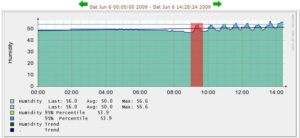The all-inclusive temperature monitoring software ideally goes beyond temperature readings. A temperature monitoring system should also monitor for several other environmental attributes including humidity, water, smoke and especially air flow among other factors. We purchase our sensors from Ravica.
Dew Point Apple Cold Storage
In order to minimize the environmental risk within a data room or cold storage facility, the conditions which can adversely affect the assets stored within these facilities must be considered. When setting up a cold storage monitoring system for apples for example, humidity is a serious concern. Apples can be stored for a long time when the temperature is kept cool (i.e. 33-34F) and the humidity high at about 90% which is almost right at the dew point. This is a dangerous game, because if the humidity is at 90% and the temperature quickly increases just one or two degrees, condensation can take place on the surface of the cooler apples. This means water droplets appear and apples could begin to rot!
Dew Point Data Center
Data center temperature monitoring on the other hand should be around 70 degrees Fahrenheit with about 50 degrees humidity. The temperature monitoring software should provide graphical trends of the temperature and humidity levels.
Above you can see that at about 9AM, the humidity level would change up and down about 5% every 15 minutes which might look like a problem but, when the room temperature is at 70 degrees and the relative humidity is at 50%, a metal surface would have to be at 50 degrees Fahrenheit for condensation to occur which could lead to rust and electrical arcs. This is unlikely to happen even with the above fluctuations. Regardless, a good temperature monitoring software solution should send notifications when ideal conditions aren’t being maintained.
Internet of Things
Temperature monitoring software introduces both good and bad features. Launching a web browser allows one to view the current environmental conditions and even set thresholds for notification when ideal ambient values aren’t being maintained. Until recently however, it never meant we could change the temperature through a web browser. The Internet of things is changing this. Devices like the Nest Thermostat allow homeowners to modify the temperature of the house all from a mobile phone. This convenience however does introduce some risks.
These types of remote visibility and control devices which allow consumers to participate in the “Internet of Things” were not designed from the ground up with security and thwarting cyber threats in mind. These devices much like the computer on your desk have operating systems which can easily be hacked and leave your house or inventory vulnerable to malicious activities. Once compromised, a remote hacker could turn off the home heating systems causing the pipes to freeze resulting in thousands of dollars in damage. Imagine the warehouse manager with billions of apples in climate controlled storage, is participating in the Internet of things worth the risk? Somethings are best left to a read only interface.
Consider your visibility vs. control needs before you invest in your next temperature monitoring software system.


